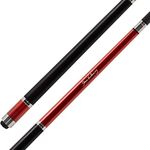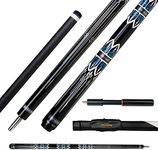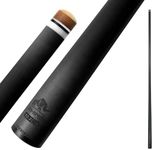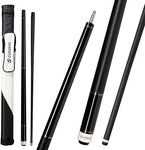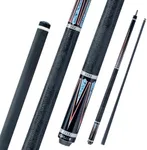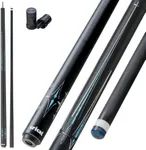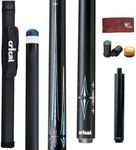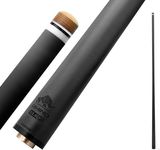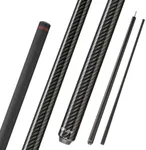Buying Guide for the Best Carbon Fiber Cue Shaft
Choosing a carbon fiber cue shaft is an exciting step for any billiards or pool player looking to improve their game. Carbon fiber shafts are known for their durability, consistency, and low maintenance compared to traditional wooden shafts. When selecting the right shaft, it's important to understand the key features that affect performance and feel. By considering your playing style, skill level, and personal preferences, you can find a shaft that enhances your control, accuracy, and overall enjoyment of the game.Shaft DiameterShaft diameter refers to the thickness of the cue shaft, usually measured at the tip. This is important because it affects how the cue feels in your hand and how much control you have over the cue ball. Thinner shafts (around 11.75mm to 12.5mm) offer more precise cue ball control and are favored by players who like to use a lot of spin, but they can be less forgiving for beginners. Thicker shafts (around 12.75mm to 13mm or more) provide a more solid hit and are easier to control for straight shots, making them a good choice for players who prefer a more traditional feel or are still developing their skills. To pick the right diameter, think about your comfort level with cue ball control and the type of shots you most often play.
Shaft TaperThe taper of a shaft describes how the shaft gradually changes in thickness from the tip to the joint. There are two main types: pro taper and European taper. A pro taper keeps the shaft the same diameter for a longer distance from the tip, which can feel more comfortable for players who use a closed bridge and want a consistent stroke. A European taper gradually widens from the tip to the joint, which can provide a stiffer feel and is often preferred by players who like a more solid hit. Your choice should depend on your grip style and what feels most natural during your stroke.
Tip Type and HardnessThe tip of the shaft is where it contacts the cue ball, and its type and hardness can greatly affect your play. Tips come in soft, medium, and hard varieties. Soft tips allow for more spin and control but wear out faster, while hard tips last longer and provide a more solid hit but less spin. Medium tips offer a balance between the two. Consider how much spin you like to use and how often you're willing to replace the tip when making your choice.
Ferrule Material and LengthThe ferrule is the small piece between the tip and the shaft, and its material and length can influence the feel and durability of the shaft. Shorter ferrules and advanced materials can reduce deflection (the cue ball moving off its intended path), which is helpful for players who use a lot of side spin. Longer or traditional ferrules may provide a more classic feel. If you want more accuracy on spin shots, look for a shaft with a shorter, high-tech ferrule.
WeightThe weight of the shaft contributes to the overall balance and feel of your cue. Lighter shafts can make it easier to move the cue quickly and are often preferred by players who like a fast, finesse style. Heavier shafts can provide more power and stability, which some players find helpful for breaking or for a more controlled stroke. Think about your physical comfort and the style of play you enjoy most when considering shaft weight.
Low Deflection TechnologyLow deflection refers to the shaft's ability to minimize the sideways movement of the cue ball when using spin. Carbon fiber shafts are often designed with low deflection in mind, making it easier to predict where the cue ball will go. This is especially important for advanced players who use a lot of English (side spin). If you are working on improving your spin shots and want more consistent results, prioritize shafts with low deflection features.
Joint CompatibilityThe joint is where the shaft connects to the cue butt, and different cues use different joint types and sizes. It's important to make sure the shaft you choose is compatible with your cue's joint. Some shafts are made to fit specific brands or joint types, while others are more universal. Check your cue's joint type before buying to ensure a proper fit and optimal performance.

